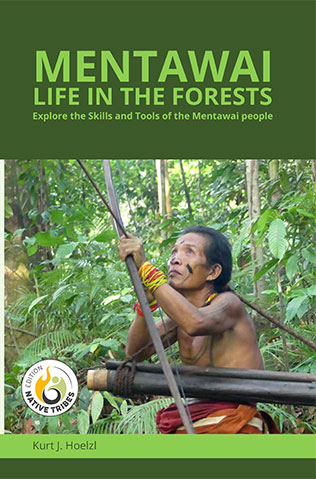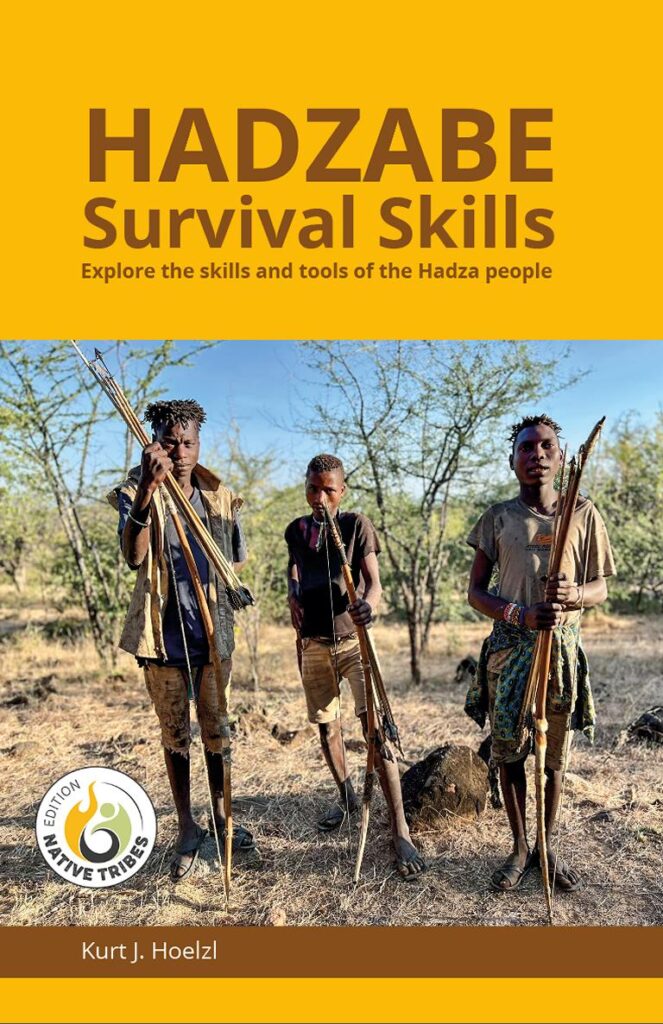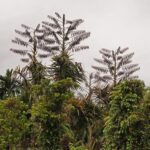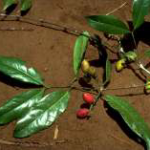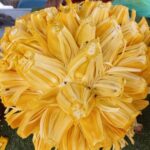The fruits eaten by Mentawai people in the forests are various species of bananas, coconuts, durians, and fruits from the rattan palm. Other fruits are also harvested, of which some grow wild, while others are planted and cultivated.
Fruits are by far more seasonal than staples and vegetables, and there is a higher variety of fruits available compared to staples and vegetables.
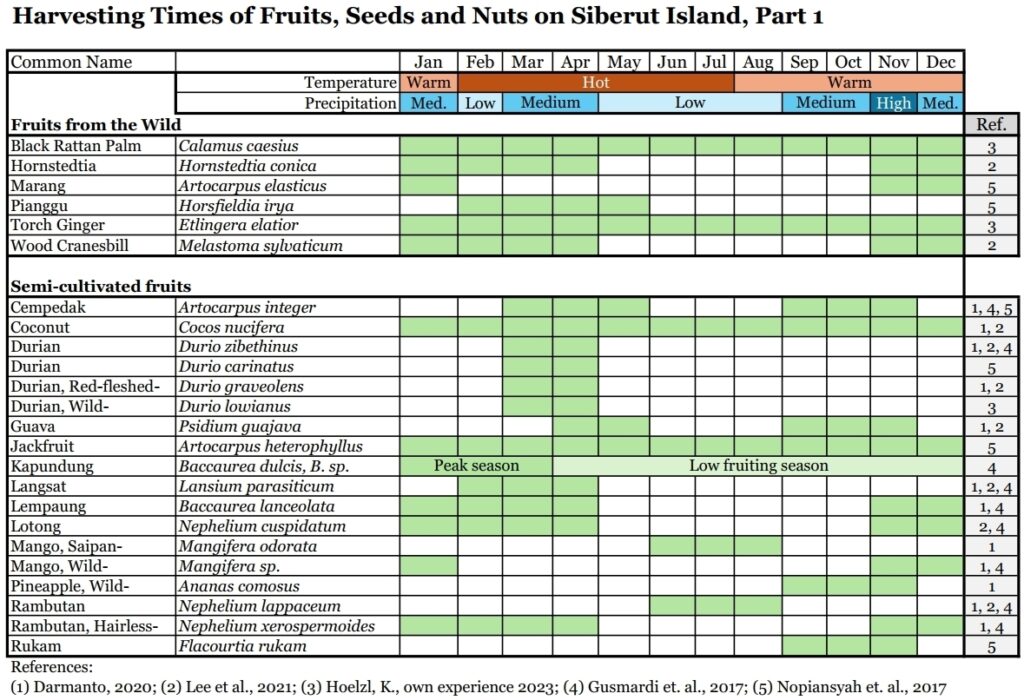
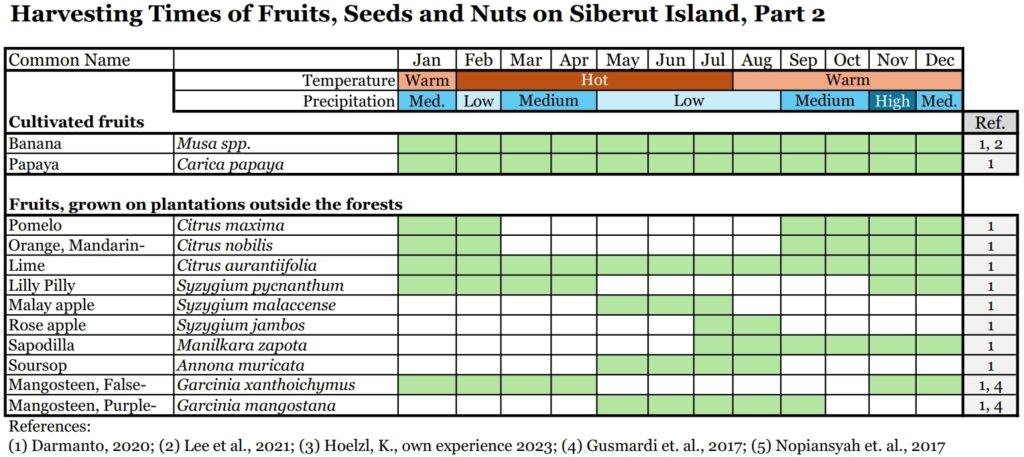
Wild fruits gathered by Mentawai people
Besides rattan palm fruits, various other fruit species grow wild in the forests. These are the fruits of the Marang tree, Torch ginger, Helmstedtia, Pianggu, and the Wild Cranesbill bush.
Black Rattan palm fruits
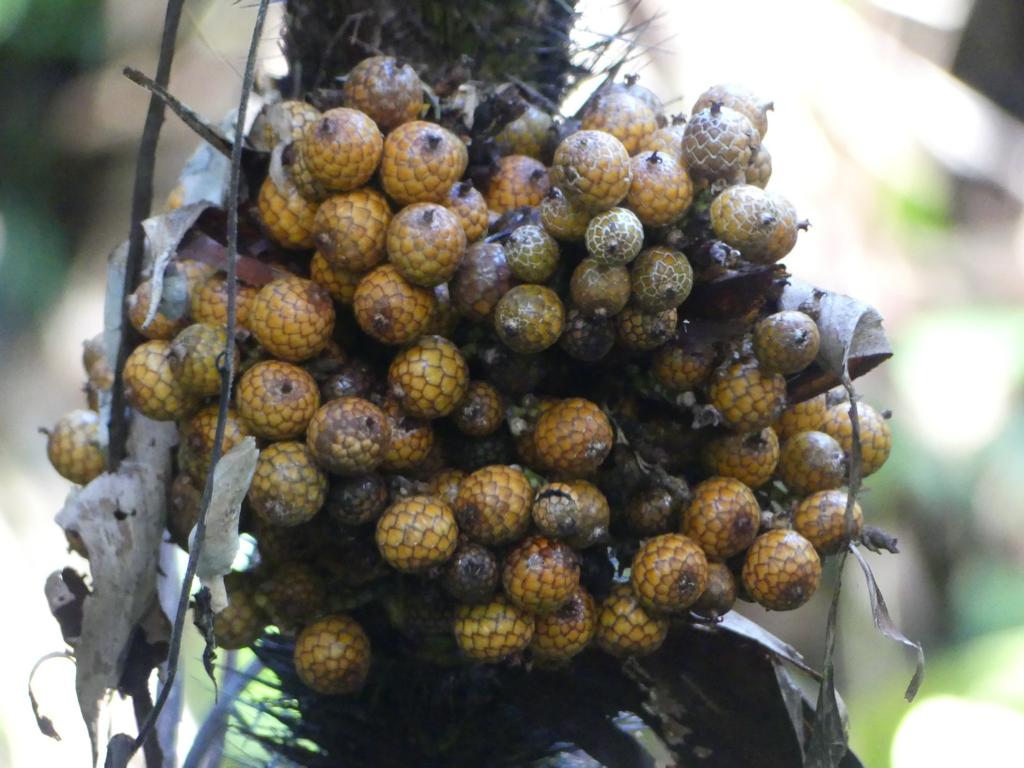
Rattan fruits are available throughout the year in all Southeast Asian rainforests. There are about 600 different species of rattans, and many of them bear edible fruits. Rattan vine stems are a valuable forest product for export. However, rattan thorns are a common nuisance when walking in the forest. Nevertheless, the usefulness of the rattan palms highly outweighs this disadvantage.
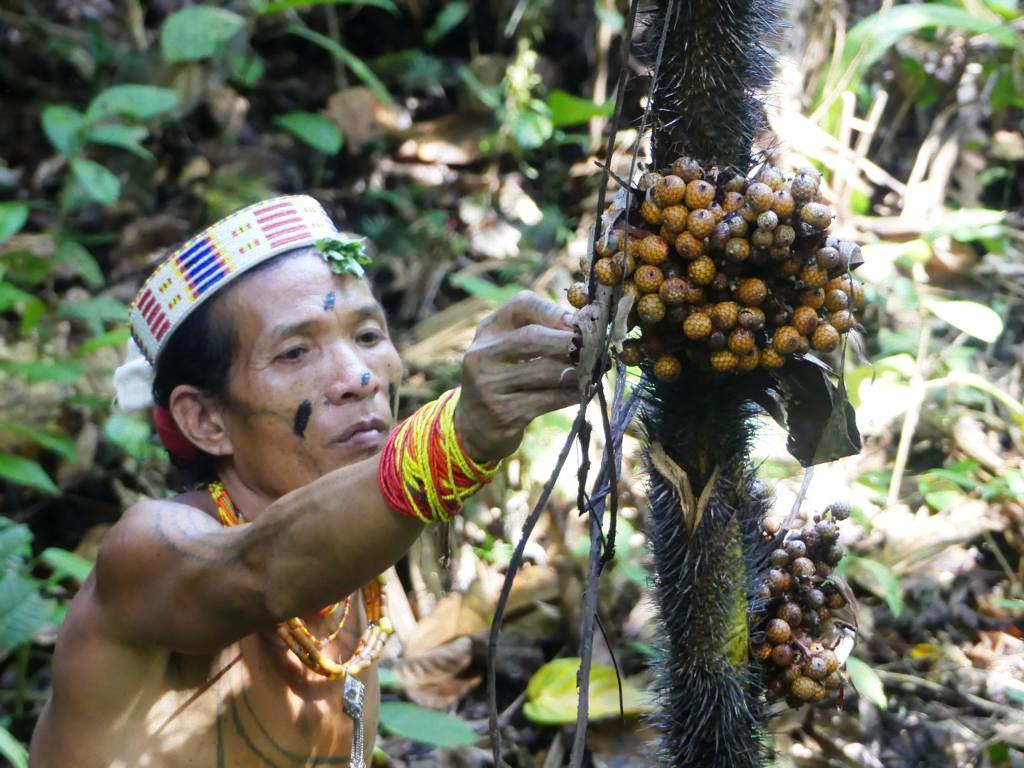
Rattan fruits are eaten, and young rattan stems contain an edible core. Moreover, there is no stronger and more flexible binding material than that of some rattan species. Furthermore, coconut graters are made out of the leaf stalks.
Rattan as a nuisance
Walking barefoot in the rainforest is the best way to grip the slippery clay below the thin leaf coverage of the ground. The pain occurs when encountering shed, old rattan leaf sheaths. This happens often at the ‘rattan belt’, about 10 meters from open water sources. There, the shed sheaths with the many prickles are a real pain for the barefoot walker. Moreover, leeches add to the nuisance. Besides prickly rattan leaf sheaths, extensions of rattan rachis, called flagella, are a nuisance. They not only try to grip other plants and vegetation to stabilize the rattan palm stem, but also catch the unsuspected wanderer wherever they can in the forest.
Rattan as a savior
On the positive side, rattan fruits with their deliciously fruity-sour taste will lift the spirits immediately after eating them. They taste delightful and let us forget all the difficulties encountered in the rainforest.
Nutritional value of fresh rattan fruits
Although the energy level of 100 g of fresh rattan fruit is not higher than 78 kcal, it is an essential source of minerals and micronutrients. One hundred grams of consumed weight contains 300 mcg copper, 3.4 mg iron, plus significant amounts of vitamin B3, sodium, potassium, and zinc.
Marang fruits and seeds
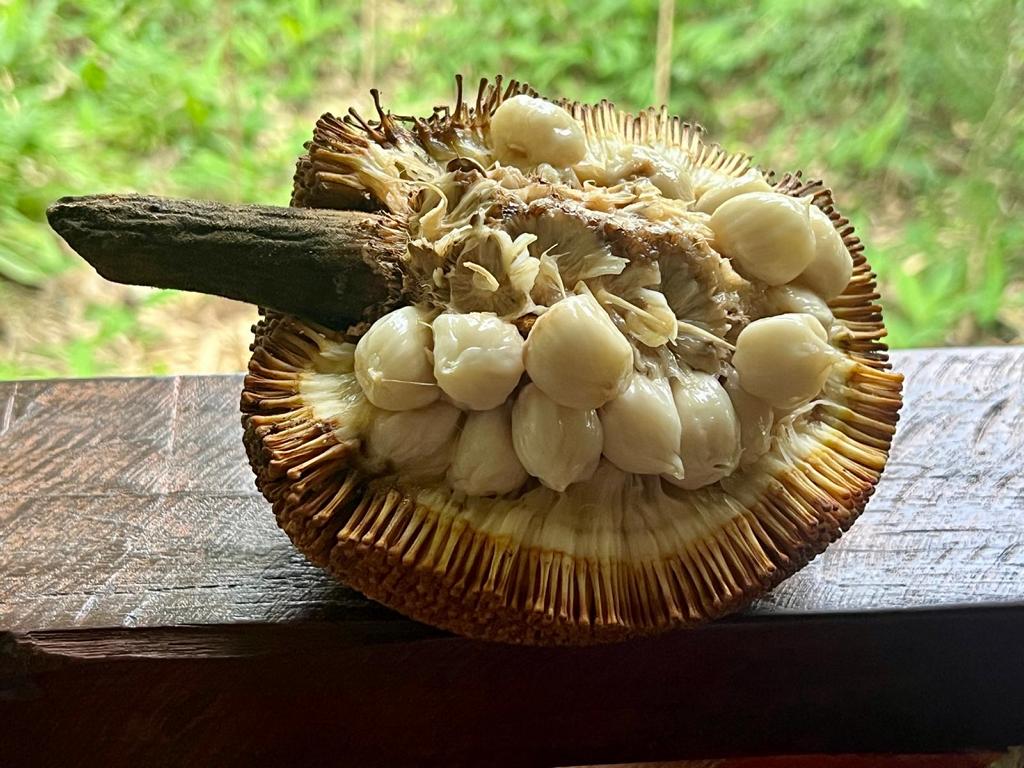
Marang (Artocarpus elasticus) is an evergreen tree growing up to 45 metres tall. The straight trunk can be free of branches for up to 30 metres. The plant has huge leaves on juvenile trees that can be over 1 metre long. The tree is harvested from the wild for several local uses, including its edible fruit and seeds, latex, fiber, leaves, and timber. Both the fruit and leaves resemble those of the breadfruit tree (Artocarpus altilis); however, the fruit of the Marang is more spiky and appears uncultivated. The sweet white pulp of the fruit is eaten, and the ripe fruit has a nauseatingly rancid smell but is nicely sweet with a savory taste. Its ripe seeds are also roasted and eaten. The oil obtained from the seeds is used to make a hair oil.
Torch Ginger fruits
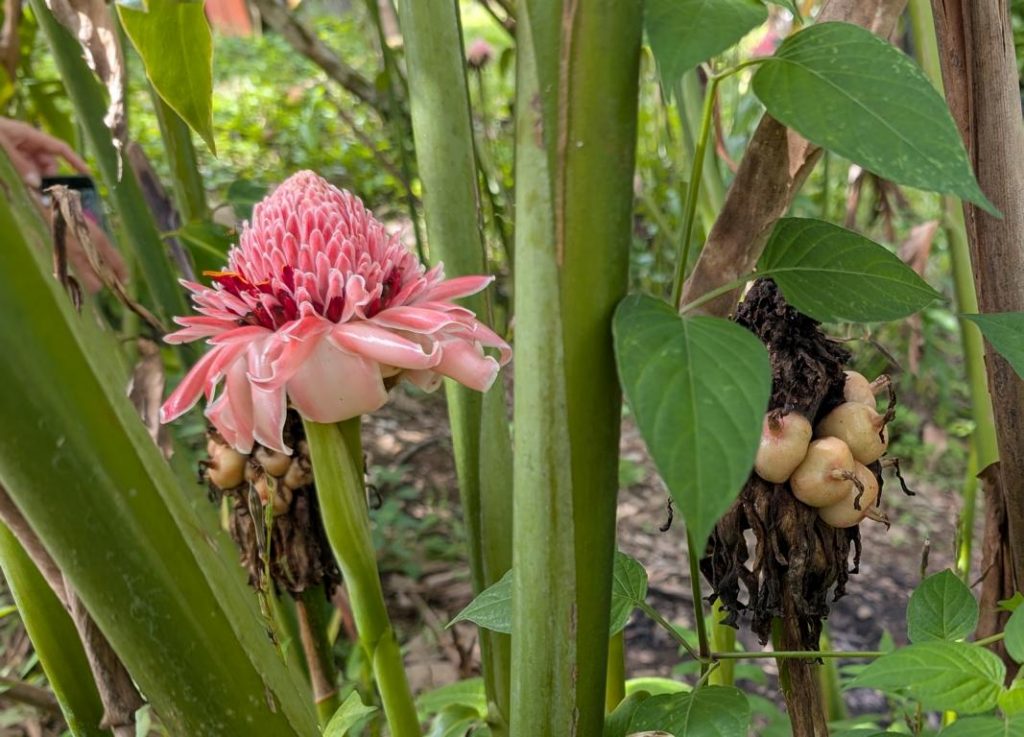
The flowers of torch ginger plants, also called Red Ginger Lily, develop into the fruit, which is an agglomeration of red berries. Botanists call this fruit type ‘subglobose’. The diameter of the fruit bunch is between 10 and 12 cm (4 and 4.7’’). Each of these ‘berries’, which make up the fruit, contains many black seeds, which are surrounded by a translucent, white, and watery aril (gel) that tastes delightfully sweet-sour and pleasant.
Hornstedtia seeds
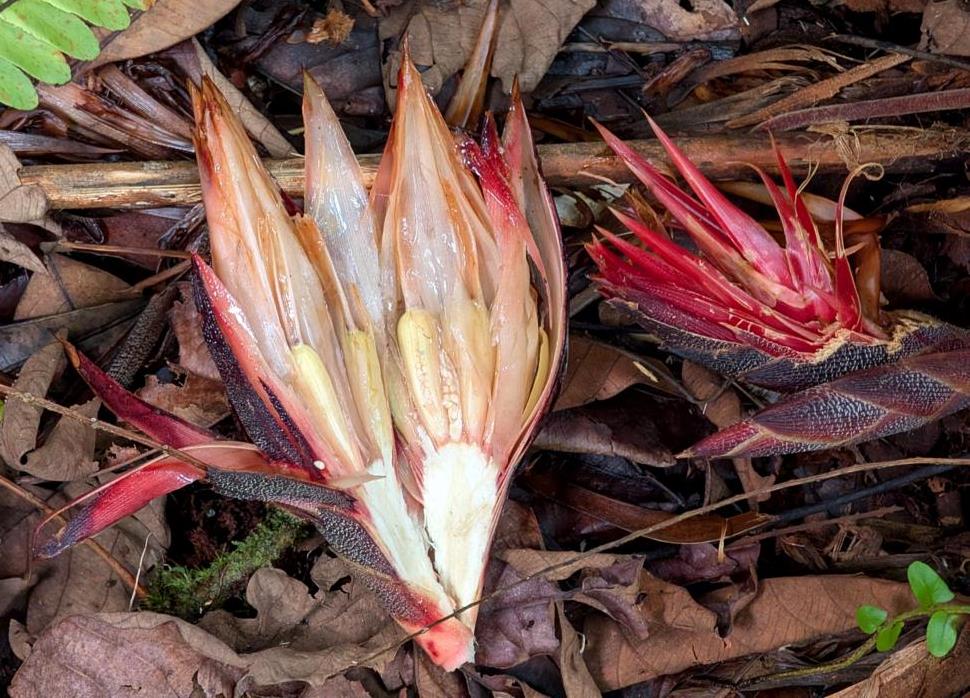
Hornstedtia conica is a slender herb that produces a cluster of leafy shoots up to 3.5 meters tall from a branched rhizome, and it closely resembles a ginger plant. The fruit spikes on the ground are harvested in the wild for food. A covering surrounds the cluster of fruits, which have a pleasantly acidic taste. The entire fruiting spike resembles garlic, measuring 4 to 5 cm in diameter and containing several fruits.
Pianggu
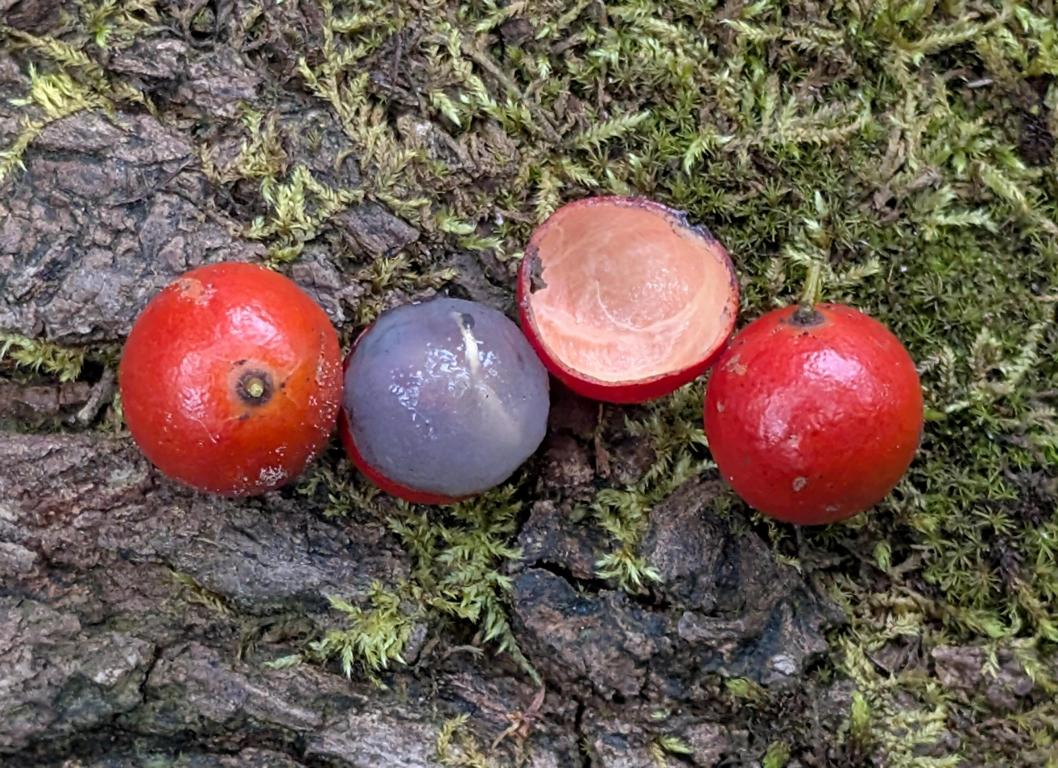
Nopiansyah et al. (2016) report that the fruits of the tree Horsfieldia irya are consumed by Mentawai people. However, there is not much more known about them. Except that monkeys also consume them.
Wood Cranesbill fruits
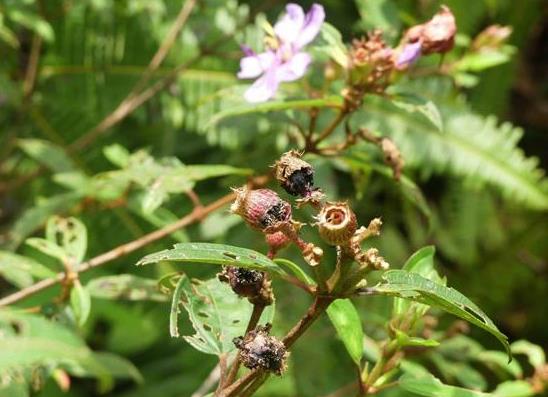
The wood cranesbill plant (Melastoma sylvaticum) typically grows in disturbed areas or open areas in secondary rainforests. Their deep purple-black berries emerge from the ripe receptacle and appear as a fleshy globe with juicy pulp and numerous seeds inside. These berries are eaten raw, but will stain the mouth pitch-black, which led to the genus name of Melastoma. Although tasting sweet, the fruits are regarded more as a fun food for kids than a serious source of nourishment.
Semi-cultivated fruits of the Mentawai
The following fruit plants were once planted in the agroforests and are now growing like wild species. It is often difficult to put these in categories, as some of them were planted a long time ago, whereas others are replanted again and again. The defining difference from cultivated fruit species is that semi-cultivated species grow without being tended or otherwise taken care of. Just the fruits are harvested regularly.
Durian
On Siberut Island, three species of durians occur. These are the following species:
- Durian (Durio zibethinus), Doriat
- Durian Daun (Durio lowianus), Toktuk
- Durian Batang(Durio malaccensis), Kinoso

Durian Daun and Durian Batang grow wild in primary and secondary rainforests and smallholder plantations. Durian (D. zibethinus) was introduced and is now a highly revered crop. All three species are essential food sources and also serve social functions, as they serve as inheritance and marriage dowries. Every man living in the area where the trees grow knows exactly the quality of the fruit from each tree and its annual harvest, which helps determine its value.
Another benefit is that flying foxes and birds will be attracted to the durian flowers, making them easy to hunt when these trees are in bloom.
When compared to durian from the mainland of West Sumatra, the striking difference between native Siberut durian and that from mainland Sumatra is its more intense aroma and flavor, which is sometimes bitter and slightly astringent. They are sweeter and develop a deeper yellowish color.
The durian season varies significantly across localities and months. It can also happen that they are in season once or twice a year, or just every two years. We saw Toktuk durians blooming in November, which means that the fruits will be ripe about 3 months later, in February the following year.
Mentawai prefer durian fruits to eat, which are not fully ripe yet, as these will not develop a stench when burping. During the durian season, all fallen fruits are allowed to be taken by anyone, even if they are not from their own tree or field. To collect the fruits, about 20 pieces will be bundled with sago leaflets into transportable packages.
Despite the abundance of durian in Siberut, some residents stated that none of them commercially distribute durian outside Siberut Island, meaning it is consumed solely for personal use on the Mentawai Islands.
Nutritional values
Sujang et al. (2024) analyzed the nutritional components of wild Durian species in Borneo, which ranged within the following values: Carbohydrates: 15.7 – 30.5 %, Protein: 2.0 – 3.7 %, Fat: 2.5 – 14.5 %. There was a high potassium content and reasonable amounts of all required macro- and micronutrients. According to him, about half of all wild Durian species are edible; the rest have either arils, which are too thin, or are inedible.
Coconuts
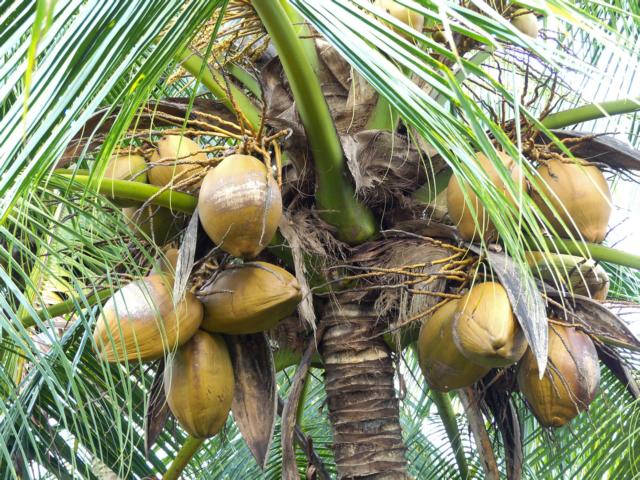
Coconuts are commonly known and do not need further explanation. Their mature meat is eaten raw, grated for dishes, or pressed for oil. When grated, the Mentawai people prefer to cover cooked taro-banana dumplings with grated coconut meat, which they call ‘Subbet’. The water of young nuts is a valuable source of hydration. Wood, husks, and leaves are used for utensils, fuel, and roofing.
Cempedak
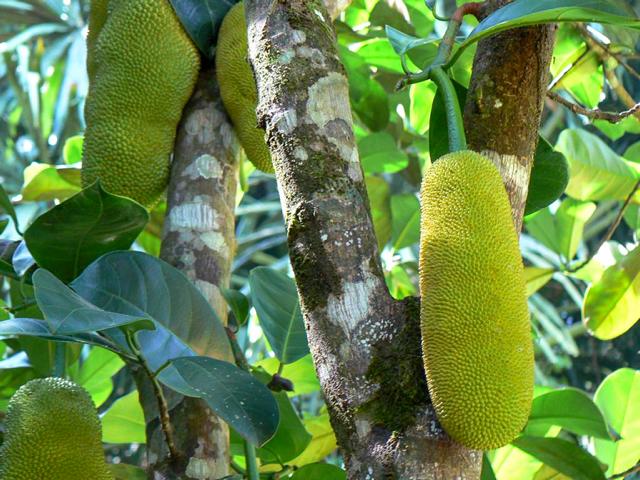
The Mentawai cempedak (Artocarpus integer) is locally known as Peigu. It is rich in carbohydrates (about 27 g). Although this species is the same as the cempedak on mainland Sumatra, the fruits on the Mentawai Islands are significantly larger than those there. Their seed arils are thick, and they have a distinctive aroma, which is sweet and smells like jackfruit and durian, and have a creamy texture. They are best enjoyed ripe or fried as fritters. Unripe fruit can be used in curries similar to jackfruit.
Guavas

Guavas (Psidium guajava) are shrubby or grow as small trees. Their fruits grow profusely and are rich in vitamin C, as well as a good source of dietary fiber. According to French (2024), 100 g of guava fruit typically provides 238 kJ of energy and 184 mg of vitamin C, plus acceptable levels of iron (1.4 mg) and zinc (0.2 mg).
Lempaung fruits
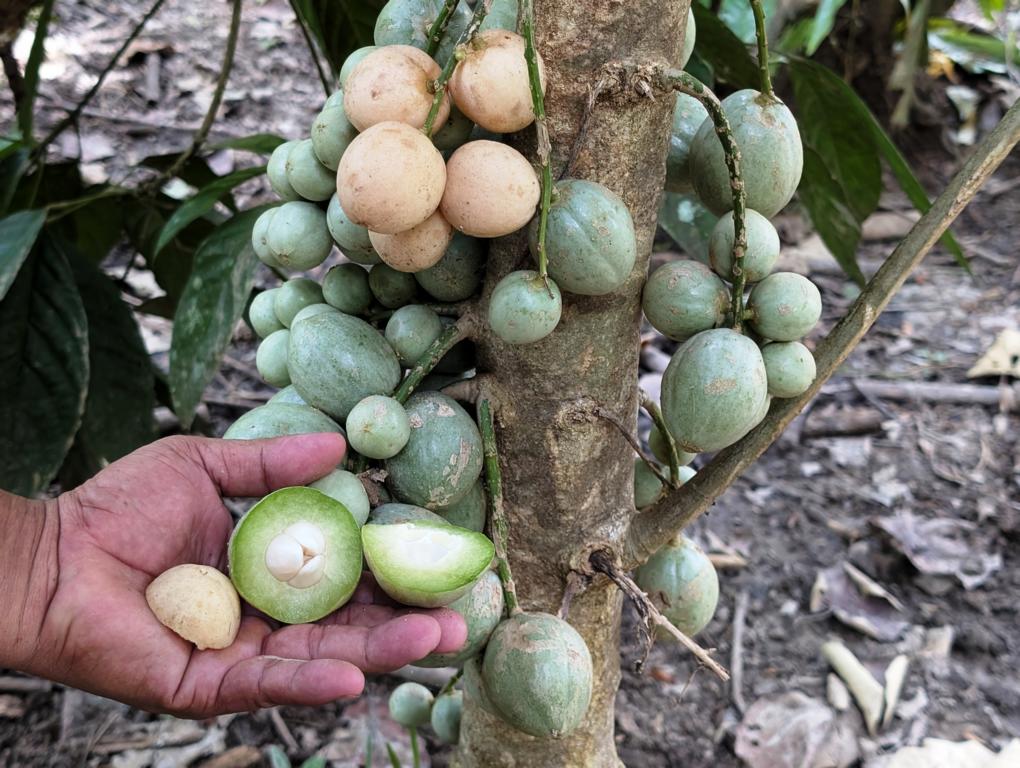
Lempaung (Baccaurea lanceolata) is one of the 51 species that belong to the Baccaurea genus. Many of these 51 species produce edible fruits. All of them occur from India, over Southeast Asia to the West Pacific. Lempaung fruits grow directly on the tree trunks, which can reach heights of up to 30 meters. These trunks are covered from bottom to top with bunches of Lempaung fruits. The fruits are creamy-white in color, thick-skinned, and contain four seeds covered with pulp of translucent white color, which tastes pleasantly sweetish-sour. Other Baccaurea species, which should be mentioned, are Kapul (Baccaurea dulcis) and Kapundung (Baccaurea racemosa). All fruits of this genus only contain small amounts of vitamins and micronutrients.
Langsat fruits
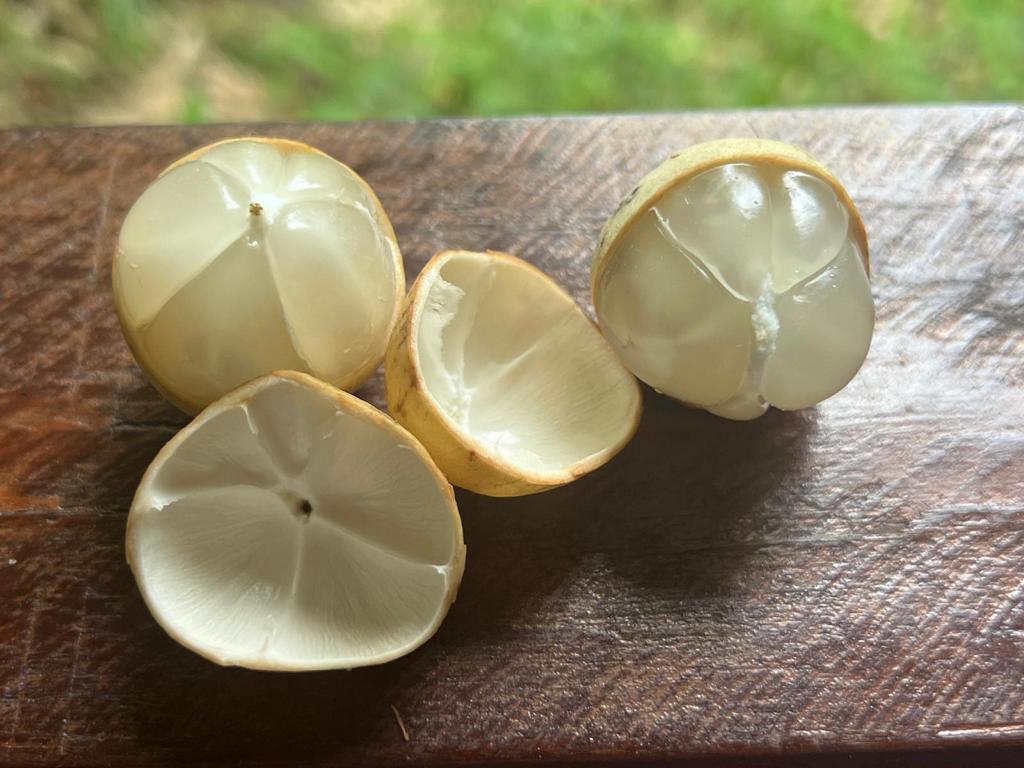
Local communities in Siberut recognize at least five variants of langsat (Lansium parasiticum, L. practicum, and others), which differ in morphological characteristics and fruit tastes. They all contain dietary fiber and small amounts of vitamin C and calcium.
Rukam fruits
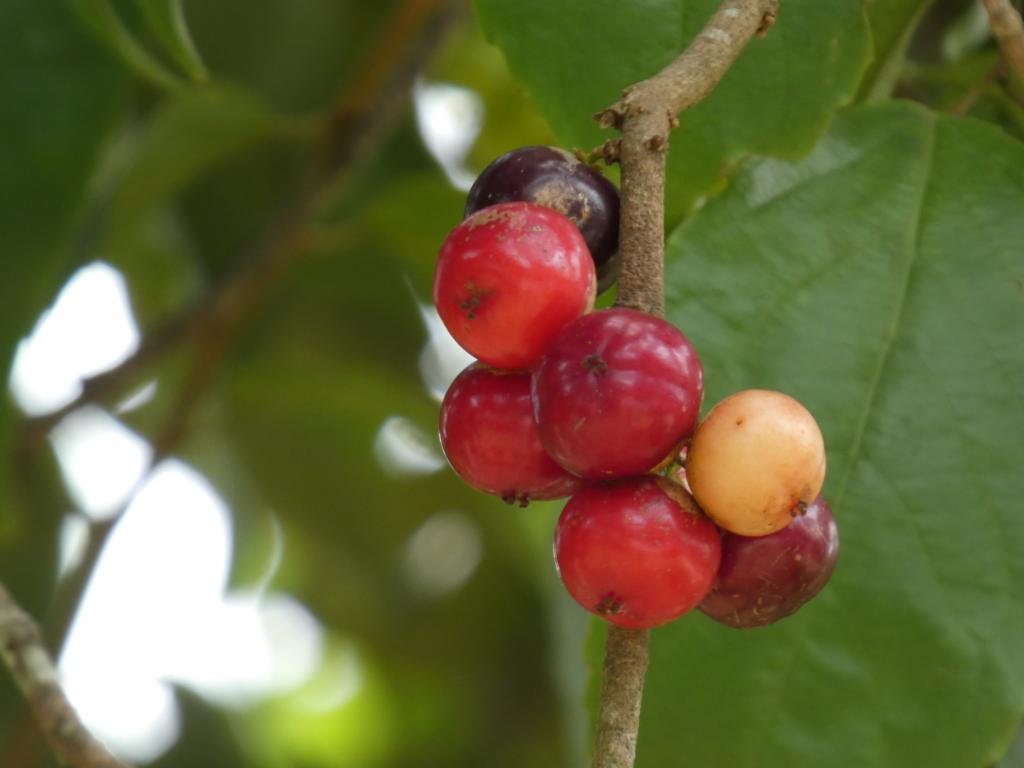
Rukam trees grow in low-lying rainforest areas from the Mentawai islands across Indonesia to the Pacific islands. Its fruits are globose berries, which are between 15 and 25mm in diameter. They contain between 4 and 7 flat seeds and a juicy, cream-colored pulp. This pulp is very acidic and astringent. Before eating them raw, they should be rolled in the hands, which reduces the astringency and turns their taste sweeter. 100 g of edible portion provides 345 kJ or 82 kcal of energy. They are also a good source of fiber, vitamin A, and minerals.
Rambutan fruits
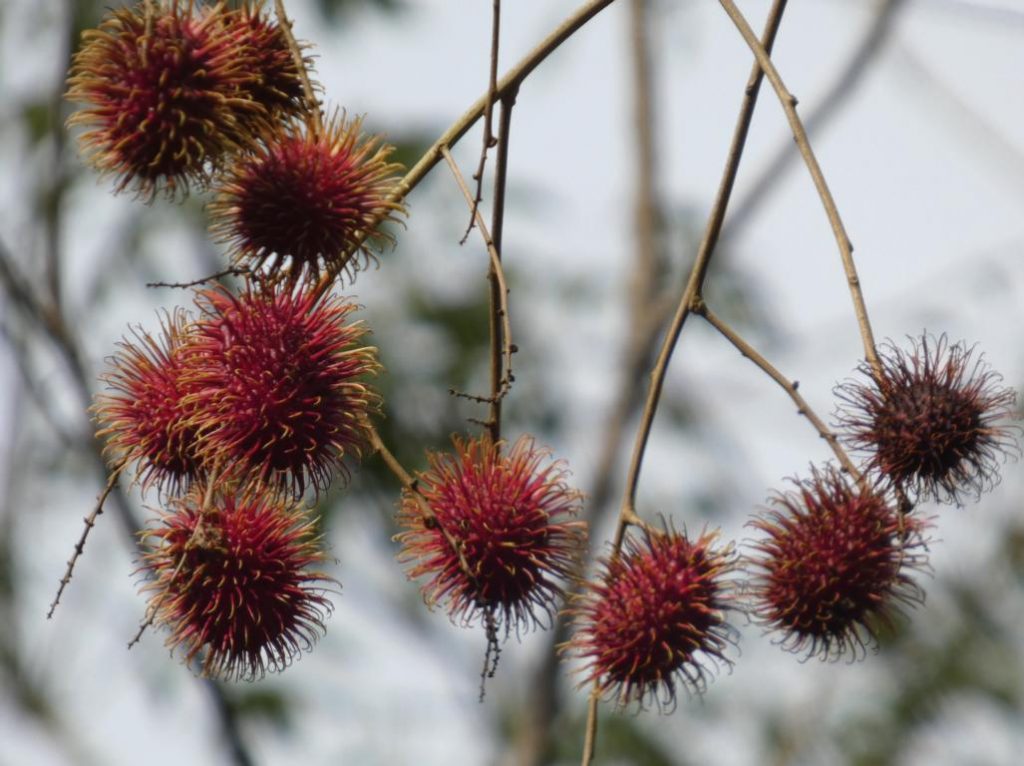
On Siberut, various Rambutan species occur. The cultivated Nephelium lappaceum was introduced, and Lotong (Nephelium cuspidatum), also called Rambutan hutan (meaning: Forest Rambutan), is the wild and native version of Rambutan. Also, the Hairless Rambutan (Nephelium xerospermoides) is cultivated. Lotong is a tree that can reach heights of up to 40 m. It is found in lowland first and second-tier rainforests, and it has long-tufted white inflorescences. The fruit is red when ripe, and densely covered with narrow, thread-like appendages. The seeds are surrounded by a white, fleshy seed coat, which is tasty. The vitamin C content of this wild species varies significantly among growing locations.
Wild Pineapple
Pineapples are botanically not a fruit, but a collection of unpollinated berries. One hundred grams of edible matter provides 209 KJ of energy. The fruits are particularly rich in vitamin C (79 mg), which is 88 % of the Daily Value, and antioxidants.
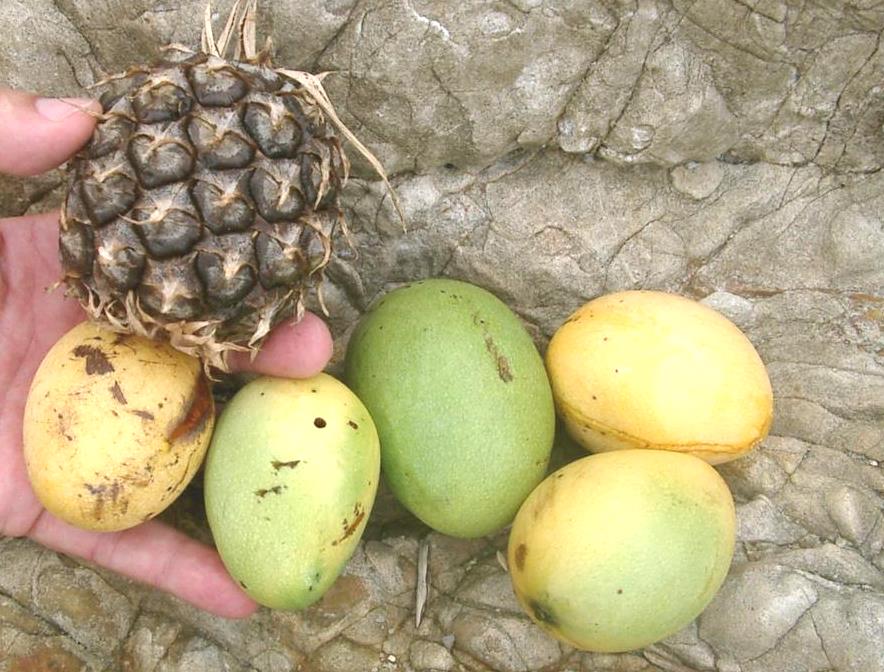
Mangoes
There are distinct genetic mango populations, including those of Indian and Southeast Asian types of mangoes. All of them were cultivated over long periods. On Siberut, various species occur, one of which is the Saipan mango (Mangifera odorata), characterized by deep yellow, sweet meat and a strong turpentine-like odor in the skin. These mangoes provide a good amount of vitamin A and C, which is beneficial for immune function and skin health.
Besides these cultivated mango species, semi-cultivated wild mangoes, which were planted long ago, are now producing small fruits. Many of them are sweet and tasty, but many are also stringy or have a strong turpentine odor. Examples can be seen in the picture with the wild pineapple above.
Cultivated fruits of the Mentawai
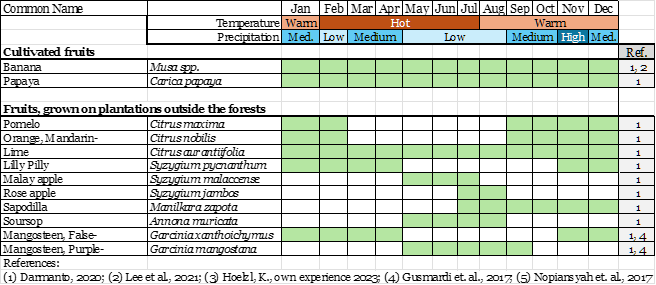
Cultivated fruits were planted by Mentawai people and are regularly taken care of. A typical example is bananas and papayas. They are both cultivated in the forests and grown on plantations adjacent to the forests.
Bananas
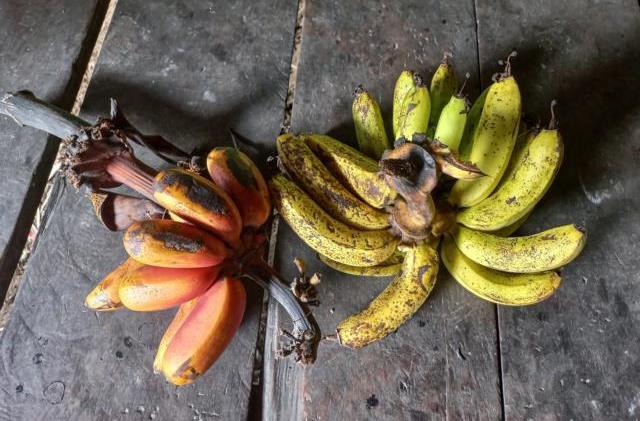
Darmanto (2020) reports that the Mentawai people in the Muntei area are familiar with 27 different species of bananas and plantains, each having a distinct Mentawai name. This illustrates the importance of these fruits to the local population. Among each species, there are significant differences in terms of taste, texture, durability, raw edibility, cooking requirements, and nutritional components. In the Uma of Aman Aru, only two species of bananas were eaten raw, of which the red variety was said to be the tastiest.
Papaya
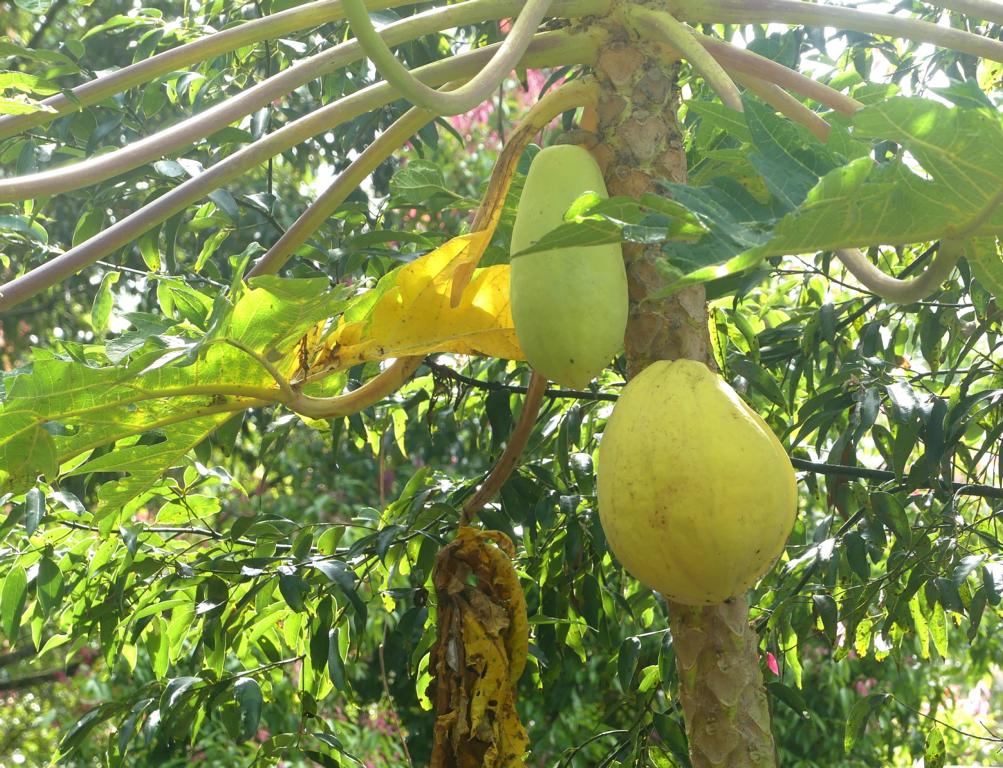
The use of young Papaya leaves and flowers was already presented in the previous chapter. In Siberut, fruits are mostly eaten ripe as a snack. They can also be eaten raw or cooked by boiling. According to French (2024), 100 g of the edible portion of a Papaya fruit typically provides 163 kJ of energy, and vitamin A (0.29 mg), vitamin C (54 mg), iron (0.4 mg), and zinc (0.18 mg).
Fruits that are only grown on plantations outside the forest
Citrus fruits, Syzygium species, soursop, sapodilla, and mangosteens are primarily grown on plantations, with no relationship to the forest-dwelling Mentawais. I, therefore, did not add pictures of them. They are just included to complete the information about the fruits growing on Siberut Island.
Citrus fruits
Various citrus species are planted and harvested. These include citrons (Citrus medica), various lime species (Citrus aurantiifolia, C. hystrix, and others), mandarin oranges (Citrus nobilis), and pomelos (Citrus maxima). Besides pomelos, which are native to the island, all other citrus species were introduced.
Syzygium species
Three Syzygium species are planted at Siberut for local consumption and export. These are Lilly Pilly fruits (Syzygium pycnanthum), Rose apples (S. jambos), and Malay apples (S. malaccense). Furthermore, S. aromaticum in this plant genus delivers the well-known spice of clove. Only the Lilly Pillies (S. pycnanthum) are native to Siberut; Rose- and Malay apples are imported species.
Soursop
The Soursop fruit (Annona muricata) is native to Central and South America. The fruits are large, oval-shaped, and have a green, prickly skin. On Siberut, they are grown for export.
Sapodilla
Sapodillas (Manilkara zapota) are native to Central America. On Siberut Island, the fruit is cultivated and eaten fresh due to the pleasant caramel aroma and for export. The ripe fruit has about five shiny black, flat seeds, surrounded by a light-brown, juicy flesh. Unripe fruits are unpalatable due to their tannin content and milky latex.
Mangosteen
Two species of mangosteens are planted and cultivated on Siberut Island. These are the standard Purple mangosteen (Garcinia mangostana) and the so-called False mangosteen (Garcinia xanthoichymus), which has deep yellow fruits when ripe. Both species taste extremely well. The Purple mangosteen is even called ‘Queen of fruits’.
Lessons learned about the fruits eaten by Mentawai people:
- The fruits available to Mentawai people can be categorized into wild fruits, semi-cultivated fruits, and cultivated fruits.
- Bananas, durians, and rattan palm provide the most important fruits for the people.
- Wild fruits in the forests are fruits of the Marang, ginger, Hornstedtia, Pianggu, and the wood cranesbill plant.
- Semi-cultivated fruits of Menatwai people are Cempedak, Wild Guavas, Lempaung, Langsat, Rambutan, Wild Pineapples, and Wild Mangoes.
- Villagers intensively cultivate all other fruits on plantations.
.

